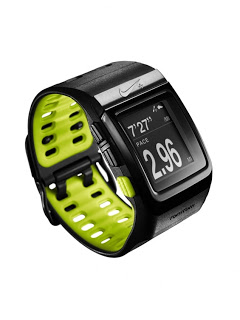Guest post by Ros (AKA Mr Nice guy)
Getting your Nike+ Sports Watch is a little like getting a new iPhone. The Box looks nice, the watch is starring you in the face the moment you open it and it looks damn good on the wrist. OK I might be a sucker for a nice looking object from time to time but I also have very high standards when it comes to things being functional.
I had read up on a number of watches including the Garmin Forerunner 610 touch screen, the Forerunner 405 and the Forerunner 305. A real range of prices and features to compare. I wasn’t really all that bothered by the touch sesitive bevel control of the 405 or the touch screen of the 610 because while running I wanted the knowledge that I was hitting a nice big button that I didn’t have to look down to find. So it came down to the 305 vs Nike+.
The 305 was well reviewed, had many features and without going into too much detail fulfilled the sort of data a physics graduate would require to analyse the crap out of any run he or she had done. I’m a physics graduate. But it was big, really big, God ugly big! Then there was the Nike+, new onto the market with much fan fair from the Nike PR department. Reviews were mixed with Garmin loyalists turning their nose up at this very good looking sports watch. I knew I had to get a GPS watch, my ability to pace myself during long runs was terrible and I needed to know how well I was doing in training for my marathon. So I took the plunge and took a punt on the Nike+ GPS Watch. After all if I wasn’t going to run very fast I might as well not run fast in style! I have a TomTom for my car so their involvement in the Nike+ GPS Watch did help sway me.
The package contains two key pieces of kit, the watch (obviously) and the Nike+ sensor that slots into your shoe. I don’t have Nike running shoes, but luckily it seems most makes of running shoe now leave a little section under the insole of your shoe for detectors of most makes.
Firstly you need to download a program onto your computer so that syncing the runs can occur. You also need to register on the Nike+ website to view your running data. The Nike+ is so heavy with graphics and flash that it feels very slow, that’s my first criticism of the Nike+ GPS Watch experience. It does let you change how you view your run between miles and kilometres but when it posts the run to your Facebook page or on Twitter it forces everyone who doesn’t have a Nike+ login to view your run in kilometres, rather annoying for someone who trains in miles.
The running experience
The watch sat on my wrist comfortably, I was really pleased with this as I have small wrists and big watches can sometimes tighten in such a way that to feel so firmly attached it cuts off the blood supply to the hand. The control menu was also really easy to use and didn’t distract me with options I didn’t need.
The watch did everything I wanted aside from an auto start/stop feature. It picked up GPS signals nice and quickly in the summer months when the sky was clear, but I did find it took longer to link the GPS when there was a thick layer of cloud.
The watch also dealt well with the times I had to run in the rain, and if you remember the summer of 2011 we had some very random monsoon-style showers, mainly on Sundays and mainly while I was doing my long run. The watch held quite a bit of charge, but not as much as some of the reviews I read claimed. I would say that you can do two 7 mile runs within a week without the need to charge the watch, if you do more than that I would charge the watch the evening before a run. If the watch is low on juice then it will only link to your foot sensor and not to the GPS so you can get some data from a run even if the watch is about to give up on you. Charging the watch doesn’t take long so if you realise just before a run pop it on for a few minutes while you get ready.
Uploading the data is easy, you plug in the watch and the Nike+ program you installed does the rest. Logging into the Nike+ site is a pain as the program automatically opens Explorer when I prefer to use Crome, this can’t be changed. The data is useful but I would have liked a bit more detail, the one thing missing that the data should be able to provide is your average stride length. With the foot sensor detecting foot impacts and the watch detecting the distance you’ve run it should be able to work out that simple sum but sadly Nike doesn’t give you that data. There are also websites that enable you to download your run data from the Nike+ site should you want to upload it to another running site.
Conclusion
I like the Nike+ GPS Watch, it’s not without its faults which mainly lie with the Nike website but if you’re not a pro runner and simply want an enjoyable easy to use GPS running watch I would definitely recommend it.


